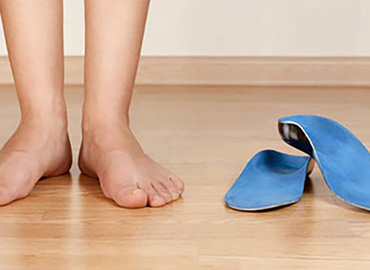Heel pain is one of the most common conditions treated by podiatrists. It is often a message from the body that something is in need of medical attention. Pain that occurs right after an injury or early in an illness may play a protective role, often warning us about the damage we have suffered.
Who gets heel pain?
The greatest incidence of heel pain is seen in middle-aged men and women. It is seen in those who take part in regular sporting activities and those who are significantly overweight and on their feet a lot. Heel pain can also occur in children, usually between 8 and 13, as they become increasingly active in sporting activities.
The Causes of Heel Pain
The research shows that higher arches or flatter arches, or feet that role in too much, are causes of heel pain. This can place too much stress on the heel bone and the soft tissues attached to it. The stress may also result from injury, or a bruise incurred while walking, running or jumping on hard surfaces, wearing poorly constructed footwear or being significantly overweight. Certain diseases can also contribute to heel pain.
Specific conditions
Plantar Fasciitis
Plantar Fasciitis is inflammation of the plantar fascia, a thick, fibrous band that runs under the foot from the heel bone to the toes. It is a vital structure that makes up the arch of the foot and functions as our natural shock-absorbing mechanism. Unlike muscle or tendons, the plantar fascia is not very elastic and therefore is very limited in its capacity to stretch or elongate. Herein lies the problem: when too much traction is placed on the plantar fascia (for various reasons) micro-tearing will occur, resulting in irritation, inflammation and pain.
Plantar Fasciitis usually causes pain under the heel, however some people may experience pain under the arch of the foot. Both heel pain and arch discomfort are related to Plantar Fasciitis, with heel pain being far more common than arch pain.

Heel Spur
A heel spur is a bony growth at the front/underside of the heel bone. This type of calcification is also referred to a “calcaneal spur” (calcaneus is the anatomical name for heel bone). The reason for the development of a spur is that the body responds to the constant traction and pulling from the plantar fascia away from the heel bone. The fascia itself cannot become any longer, so instead the bone will ‘assist’ the fascia and grow. They can also form on other areas of the body including the posterior (back of) the heel bone also due to the pull of the Achilles tendon at its attachment onto the heel.
A heel spur will show clearly on an X-Ray of your foot and this referral for an X-ray may be made if a heel spur is suspected. This is often a factor that is predictive of the long term prognosis of the heel pain; if a heel spur is found, the likelihood of recurrence of pain is high so biomechanical correction will be required indefinitely. Spurs take many years to develop and indicate that there has been tension on the bone for a long period of time. They can worsen if the tension in the fascia (or tendon) is not reduced.
It should be noted that a heel spur may be found incidentally on an x-ray but not be producing any pain for the individual. It is however a risk factor for heel pain due to the formation of one being due to tension on the bone so one should be mindful of this as precautions can be made to minimize the risk of the spur becoming symptomatic.
Achilles tendonitis
Is a common injury in athletes particularly those doing sports involving running and jumping. The Achilles tendon attaches the calf muscles to the back of the heel and can become inflamed with overuse of the calf muscles. The pain is felt either on the back of the heel on the bone or a few centimetres above and may have swelling or thickening felt in the area.
Being a tendon, this injury responds well to stretching and specific exercises. In addition, reducing the load through the tendon with activity modification and orthotic therapy greatly improves the recovery time.

Sever’s Disease
In teenagers, pain around the heels is usually a sign of Sever’s disease, a condition caused by the Achilles tendon placing extra strain on the heel bone and swelling in the growth plate around the heel. Sever’s disease will ultimately resolve as the growth plate around the heel bone fully develops and the bones fuse by approximately age 15, but damaging foot problems can develop through altered biomechanics. Early treatment can relieve discomfort and prevent the incidence of additional injury.

Treatment options
Early treatment might involve shoe recommendations, taping, icing and anti-inflammatory medication. Other physical therapies may also be used which include shockwave, exercise, stretching and strengthening program and prescription orthotics for long term management. As a general rule of thumb, the longer the injury has been going on without treatment, the longer it will take to recover so it is always advised to have the pain seen to early to ensure a speedy recovery.
How do orthotics help heel and arch pain?
Any slight alteration to foot posture or function can cause significant discomfort due to increased load through particular muscles/tendon/fascia/joints. To help alleviate foot and lower limb pains, or in some people to prevent the development of potential problems, an orthotic can be prescribed. Your podiatrist will be able to assess if you would benefit from an orthotic device. The assessment will involve observation of the feet and lower limb standing, running / walking and also an examination when non weight bearing to check the joints. From this assessment, the orthotic can be made for the shoe that provides support for the appropriate areas of the feet.


